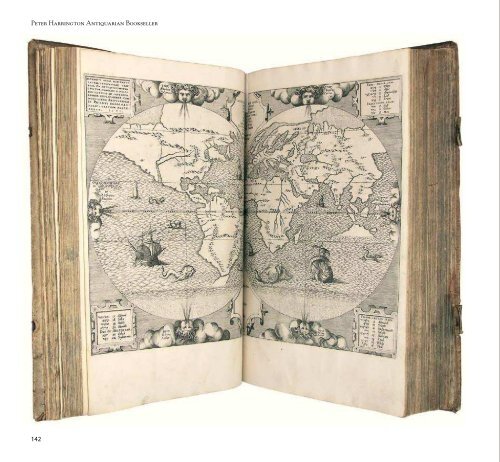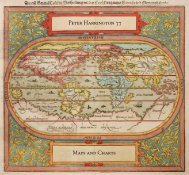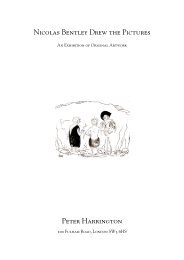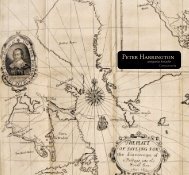antiquarian bookseller - Peter Harrington
antiquarian bookseller - Peter Harrington
antiquarian bookseller - Peter Harrington
You also want an ePaper? Increase the reach of your titles
YUMPU automatically turns print PDFs into web optimized ePapers that Google loves.
<strong>Peter</strong> <strong>Harrington</strong> Antiquarian Bookseller<br />
142<br />
WITH EARLY WORLD MAP<br />
DEPICTING AUSTRALIA AS AN<br />
ISLAND<br />
278.ARIAS MONTANO,<br />
Benito.<br />
[Tractatus ad Sacr. Bibliorum<br />
apparatum pertinentes] Communes<br />
et familiares Hebraicae linguae<br />
idiotismi, omnibus bibliorum<br />
interpretationibus, ac praecipuè<br />
Latinae Santis Pagnini versioni<br />
accommodati, atque ex variis<br />
doctorum virorum laboribus &<br />
observationibus selecti & explicati<br />
… [and other treatises].<br />
Antwerp, Christopher Plantin, 1572 [30021] £11,250<br />
Single folio volume (408 × 282 mm) in 18 parts, pp. 24; [viii],<br />
118, [8], [2] bl.; 26, [2]; 20; 14, [2]; 10, [2] bl.; 18, [2]; 7; 11; 22,<br />
[2]; [60]; [14], [2] bl.; 11; 33, [2]; 54, [1]; 59, [1]; [2] bl.; [iv], 12,<br />
198; [xxiv], 141, [3]. Engraved vignette, 3 double-page maps,<br />
9 engraved plates (1 double-page), woodcut title-vignettes,<br />
some Hebrew type. Contemporary blind-stamped pigskin<br />
over reverse bevelled wooden boards, spine with eight<br />
raised bands, brass catches, clasps defective, lacking metal<br />
cornerpieces, remains of paper shelf-label at head of spine,<br />
early manuscript titling on spine now faded. Early ownership<br />
inscriptions at head of title, one partly erased. Extremities<br />
rather worn, a scattering of wormholes to lower inside board<br />
and last few leaves, last few gatherings affected by spill-burn<br />
in outer margin not touching the text, light water stain at foot<br />
throughout, a very good copy.<br />
FIRST EDITION. A fine contemporary volume containing<br />
eighteen treatises from the Apparatus Sacer of the<br />
Plantin Polyglot Bible, illustrated by three maps<br />
highly sought-after in their own right. The Apparatus<br />
Sacer, edited by Benito Arias Montano (1527–1598),<br />
is a body of supplementary material to the bible<br />
unprecedented in quantity and comprehensiveness,<br />
Catalogue 57: Travel Section 7: Mapping, Navigation and Naval History<br />
comprising a number of learned treatises that add up<br />
to a complete ethnography of the ancient Hebrews.<br />
The ornate double-hemispheric world map (Shirley 125,<br />
state 1) found here illustrates the treatise “Phaleg”, which<br />
deals briefly with the repopulation of the postdiluvial<br />
world. The map depicts modern discoveries, including<br />
Australia shown as a distinct island rather than as part<br />
of an undifferentiated southern landmass, one of the<br />
earliest maps to do so. Its toponymy, however, is based<br />
exclusively on the bible and it is lettered throughout in<br />
Hebrew, including the cardinal directions in the frame.<br />
Montano wanted to assert the status of Scripture as the<br />
basis of all human knowledge without denying the truths<br />
found in pagan and modern philosophies; to this end he<br />
identifies the biblical gold-bearing region of Ophir with<br />
Peru, placing it on his world map on the western littorals<br />
of the two continents of the New World. The Ophir–Peru<br />
theory, by implication, made the flattering suggestion<br />
that Philip II, the sponsor of the Plantin Polyglot,<br />
and his Escorial were prefigured by Solomon and the<br />
Temple. The theory required some linguistic gymnastics.<br />
Ortelius, his close friend, lavished praise on Montano’s<br />
erudition but remained unconvinced by the argument.<br />
The volume also contains two further maps – depicting<br />
Canaan at the time of Abraham (Laor 45) and the land<br />
of Israel divided among the twelve tribes – which form<br />
the most important representation of biblical geography<br />
produced in the late 16th century before the publication<br />
of Christiaan van Adrichem’s Theatrum Terrae Sanctae<br />
in 1590, itself indebted in many respects to Montano.<br />
Montano insisted on correct historical stratification in his<br />
account of the Holy Land, separating it into two treatises:<br />
“Chanaan” discusses the land before its conquest and<br />
redistribution by Joshua; “Chaleb” deals with the later<br />
period. The Canaan map is exceptional in Montano’s<br />
effort to provide place names in Hebrew script. In<br />
“Chaleb” Montano explains that his map of Israel was<br />
intended as a replacement for pilgrimage for those who<br />
could not travel and enjoy the memory of actual places.<br />
Montano’s inclusion of maps in the Plantin Polyglot was<br />
groundbreaking: prior to this, the inclusion of maps<br />
in bibles was a predominantly Protestant practice.<br />
Also included here is Montano’s treatise on sacred<br />
architecture, “Exemplar”, which argues that the classical<br />
architectural orders derived from designs described in the<br />
bible, to which end he analyses in detail the construction<br />
and appearance of Noah’s Ark, Solomon’s Temple and<br />
the Tabernacle. One of the illustrations of the Ark shows<br />
its dimensions superimposed onto the body of Christ in<br />
a manner reminiscent of Leonardo’s famous illustration<br />
of the proportions of the human figure (Vitruvian Man).<br />
The full Apparatus Sacer takes up the last three of the eight<br />
folio volumes of the Plantin Polyglot. Its bibliography<br />
is complicated. This volume contains the bulk of the<br />
treatises usually found in vol. 8, supplemented with four<br />
linguistic treatises from vol. 6, these latter with reverse<br />
pagination. “Various copies are differently bound up …<br />
Arias himself is not always consistent in referring to the<br />
volumes of the Apparatus Sacer. Some copies, again, have<br />
different editions of the treatises contained in vols. 6 and<br />
8” (Darlow & Moule). The contents of our volume are as<br />
follows: (1) Communes et familiars Hebraicae linguae<br />
idiotismi … 1572; (2) Liber Joseph, sive, de arcano<br />
sermone … 1571; (3) Liber Jeremiae, sive, de actione<br />
… 1571; (4) Thubal-Cain, sive de mensuris sacris liber …<br />
1572; (5) Phaleg, sive, de gentium sedibus sive de terrae<br />
promissae partitione … 1572; (6) Liber Chaleb, sive de<br />
terrae promissae partitione …; (7) Exemplar, sive, de<br />
sacris fabricis liber … 1572; (8) Liber Chanaan, sive de<br />
duodecim gentibus …; (9) Daniel, sive, de saeculis codex<br />
integer … 1572; (10) Index Biblicus …; (11) Hebraea,<br />
Chaldaea, Graeca et Latina nomina …; (12) Variarum<br />
in Graecis bibliis lectionum libellus …; (13) Illustriss. D.<br />
Sirleti S.R.E. Cardinalis, annotations variorum lectionum<br />
in psalmos … 1571; (14) Variae lections in latinis bibliis<br />
editionis vulgatae … 1572; (15) Syrorum peculium …<br />
1571; (16) Grammatica linguae syriciae … 1571; (17)<br />
Dictionarium Syro-Chaldaicum … 1572; (18) Thesauri<br />
Hebraicae Linguae … 1572. According to the collation<br />
given in Darlow & Moule, no. 1 here belongs properly to<br />
vol. 7, nos. 2–14 belong to vol. 8 and nos. 15–18 to vol.<br />
6. COPAC gives the collation of a single volume similar but<br />
not identical to ours held by Glasgow University Library.<br />
Darlow & Moule 1572.<br />
143








